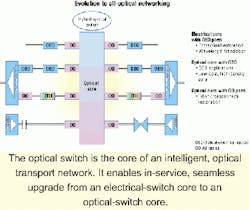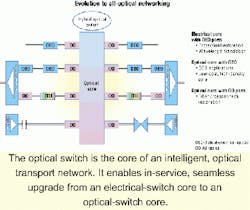Hybrid optical switching: best of both worlds
As new all-optical technology beckons, the reality is that electrical conversions will play a key role in optical networks for quite some time.
RON MACKEY, Tellabs
The promise of an all-optical network looms before carriers like a mirage, just slightly out of reach. This pure photonic play evokes images of infinite scalability across bandwidth that is broad enough to support all the high-end applications that carriers dream of and many that have yet to be conceived.
Such a platform could satisfy the seemingly insatiable demand for network capacity and intelligent applications such as bandwidth on demand. Eventually, an end-to-end optical design will deliver that bandwidth at a significantly lower cost per bit than today.
The harsh reality, however, is that pure photonic networks aren't necessarily the best or most efficient way to deliver end-to-end services. Today, end users don't generally require a wavelength or fiber's worth of bandwidth. Commercial viability of pure photonic switches with thousands or tens of thousands of ports has yet to be realized. Hybrid all-optical/electrical switches are available that address today's network requirements, while delivering a seamless migration path to tomorrow's pure photonic realm.
The appeal of photonics misleads some providers to describe their networks as "all optical" when in fact almost all networks require some amount of manipulation of signals in the electrical domain. At the edge of the network, low-speed electrical signals are generally multiplexed onto higher-speed optical wavelengths. Performance monitoring in the electrical domain ensures that the network is meeting the customers' service-level agreements (SLAs).
Even in the core of most transport networks, electrical signals are used to regenerate signals that have traveled hundreds or thousands of kilometers. At intermediate sites, high-speed wavelengths such as OC-192 (10 Gbits/sec) or OC-768 (40 Gbits/sec) may be converted back into the electrical domain for regrooming and refilling. Pure photonic services can extend the distances the network may carry individual signals, but whenever the signal needs to be broken down into its constituent components, an electrical conversion is usually required.
With DWDM systems now capable of placing terabits of information on a single fiber, the jump from electronic to optics promises service providers scalability for the future. As core transport changes, photonics offers the hope of seamless upgrades for the future. Today's SONET OC-48 (2.5 Gbits/sec) will be replaced with OC-192 and OC-768. Service providers will immediately have the ability to migrate to these higher-speed services without incurring any upgrade costs. The economics of optical switching is the key that unlocks the cost-per-bit ratio, because it promises to deliver more bits at an order of magnitude less expensive than what service providers pay today.
Capacity expansion is only one of the benefits of pure photonic networks. Generally speaking, photonic switches are denser and require an order of magnitude less power than electrical-based switches. Power-starved areas like California can reap immediate benefits from lowering power requirements.
Optical technologies such as DWDM have long since found favor with interexchange carriers. Now, these long-haul providers are extending their reach into the metro area and taking their photonic preferences with them.
The value proposition for hybrids on the local level takes a slightly different spin. Bandwidth becomes important in the prevention of bottlenecks and to support Gigabit Ethernet services to the home and business. Hybrids are ripe with capacity to switch thousands of ports simultaneously to support such sophisticated applications.
Provisioning intervals are just as important as capacity, if not more so. End users have little tolerance for long service delays. If a customer is paying for a Gigabit Ethernet connection or an OC-48 at the edge of the network, the expectation is that service will be turned up within a matter of days and not weeks. Bandwidth on demand will trim that interval further. It quickly becomes a matter of the provider that turns up service first will win.
The problem with the fully optical approach is that photonic switches are not commercially available in the required size and density to meet carrier-class requirements. Hybrid switches that meet the exacting demands of carriers, however, are here today.
A hybrid switch blends optical-switching concepts with an electronic core to yield an impressive progeny that provides a seamless upgrade path to a pure photonic switch in the future. One of the immediate observations is that switching in silicon is well understood. Carrier-class switches that scale to thousands or tens of thousands of ports are commercially possible today.Advances in digital technology are still moving in alignment with Moore's Law. Today's hybrid switches consume an order of magnitude less power per bit than yesterday's systems and can be built with impressive densities. Recently announced products have pushed the terabit-per-equipment-bay limits, offering support for hundreds of OC-48 ports within a single bay of equipment. There is no reason to believe that advances in digital-switching technology won't keep pace with tomorrow's capacity requirements.
Hybrid switches can incorporate performance monitoring, protection switching, signal regeneration, wavelength translation, and network demarcation services, which aren't available in today's limited all-optical world. The lure of the all-optical world has some providers overlooking the irreplaceable benefits found in the optical-electrical-optical (OEO) realm. Several techniques found in the electronical domain do not translate into the optical arena-for example, a simple switching feature such as bridge-and-roll. Bridge and roll is used to link a live circuit to another outgoing circuit before traffic is interrupted on the original circuit. When traffic is interrupted on the original circuit, the secondary circuit immediately takes over, so there is no loss of service. That is easily performed in the electrical domain. It is not so easy in the photonic domain.
Multicasting or broadcasting to a number of ports is another feature currently elusive in the pure photonic world. Multicasting enables the service provider to drop a port and actually continue that same signal across another port or group of ports. Photonic equipment focuses on switching light and therefore doesn't typically offer an opportunity to move between multiple ports or multicast to a number of outgoing ports.
Subwavelength multiplexing is also difficult in the photonic domain. When carriers use a hybrid interconnection to link multiple WDMs, they retain the ability to extract a subwavelength out of the high-speed wavelengths and redirect lower-speed channels out of those high-speed pipes. Take the case of a carrier that has an OC-192 going from New York to Los Angeles. In Kansas City, the carrier may want to pull off an OC-48 and drop it in Kansas City, then add another wavelength. The carrier can multiplex the wavelengths back together, then send them on. With a hybrid that integrates add/drop multiplexer functionality, the carrier can accommodate separate multiplexing and aggregation. That's an advantage the pure photonic player would not have.
Hybrid switches have the ability to maintain these inherently electronic features even after the switching core is upgraded to photonics. A hybrid switch consisting of a photonic core coupled with electrical ports could potentially support many of the features outlined here, while retaining the benefits of the pure photonic core.
Hybrid-switch design requires merging the best of both the electrical and photonic technologies. Electrical switches are relatively easy to design, although these devices are limited in scalability. Pure photonic switches are also easy to design but limited in carrier-class functionality. A hybrid switch combines the feature set of the electrical switch and scalability of the photonic switch.
To get the best of both domains, carriers should opt for a vendor with expertise in both the electrical and optical world. The most common interconnections between a port shelf and switch shelf are usually electrical or multimode fiber. However, when the switch shelf is upgraded to a pure photonic core, those types of interconnections can't carry the new traffic through the core. Hence, a singlemode-fiber design that interconnects between all the ports and all the switch processors is generally required in hybrid solutions. Vendors that take this extra step make the upgrade to photonics seamless and less expensive for their customers. In this mode, the upgrade occurs in service without the need for changing cabling (see Figure).
Consensus is a rare thing in the dynamic world of communications; optical networking is an exception to this rule. The question for most carriers is not whether to migrate to pure end-to-end photonics, it's when. Perhaps the more important issue is finding alternatives that make the transition smooth.
Hybrid solutions are most powerful when the technology maximizes an em-bedded investment and lays the foundation for the next wave of enhancements. Part of that strategy is to incorporate and prepare for next-generation technologies such as digital wrapper. Digital wrapper is important to service providers because of the flexibility and extendibility it affords. As a transport layer, it's a separate signal that encapsulates critical performance information such as routing, signaling, and error correction.
The sum of all the attributes of hybrid optical-switching elements pays big dividends in service delivery. These amalgamations help win the race to deliver bandwidth, because the technology is available unlike fully optical alternatives.
Not only does the hybrid equipment lead the current field, it also incorporates the optically focused technology expected to come into its own within the next few years. Hybrids that so deftly bridge the optical and electrical worlds promise thoroughbred performance today and tomorrow.
Ron Mackey is director of product management and planning for the optical- networking group at Tellabs (Lisle, IL).

